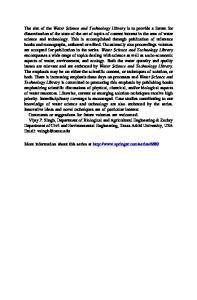Nile River Basin Ecohydrological Challenges, Climate Change and Hydr
The book provides a comprehensive overview of the hydrology of the Nile River, especially the ecohydrological degradation and challenges the basin is facing, the impact of climate change on water availability and the transboundary water management issues.
- PDF / 21,271,832 Bytes
- 702 Pages / 439 x 666 pts Page_size
- 97 Downloads / 387 Views
Assefa M. Melesse • Wossenu Abtew Shimelis G. Setegn Editors
Nile River Basin Ecohydrological Challenges, Climate Change and Hydropolitics
2123
Editors Assefa M. Melesse Department of Earth & Environment ECS 339 Florida International University Miami Florida USA
Shimelis G. Setegn Florida International University North Miami Florida USA
Wossenu Abtew South Florida Water Management District West Palm Beach Florida USA
The facts and opinions expressed in this work are those of the author(s) and not necessarily those of the publisher. ISBN 978-3-319-02719-7 ISBN 978-3-319-02720-3 (eBook) DOI 10.1007/978-3-319-02720-3 Springer Cham Heidelberg New York Dordrecht London Library of Congress Control Number: 2013958382 © Springer International Publishing Switzerland 2014 This work is subject to copyright. All rights are reserved by the Publisher, whether the whole or part of the material is concerned, specifically the rights of translation, reprinting, reuse of illustrations, recitation, broadcasting, reproduction on microfilms or in any other physical way, and transmission or information storage and retrieval, electronic adaptation, computer software, or by similar or dissimilar methodology now known or hereafter developed. Exempted from this legal reservation are brief excerpts in connection with reviews or scholarly analysis or material supplied specifically for the purpose of being entered and executed on a computer system, for exclusive use by the purchaser of the work. Duplication of this publication or parts thereof is permitted only under the provisions of the Copyright Law of the Publisher’s location, in its current version, and permission for use must always be obtained from Springer. Permissions for use may be obtained through RightsLink at the Copyright Clearance Center. Violations are liable to prosecution under the respective Copyright Law. The use of general descriptive names, registered names, trademarks, service marks, etc. in this publication does not imply, even in the absence of a specific statement, that such names are exempt from the relevant protective laws and regulations and therefore free for general use. While the advice and information in this book are believed to be true and accurate at the date of publication, neither the authors nor the editors nor the publisher can accept any legal responsibility for any errors or omissions that may be made. The publisher makes no warranty, express or implied, with respect to the material contained herein. Printed on acid-free paper Springer is part of Springer Science+Business Media (www.springer.com)
Preface
Water is vital to life but its availability, distribution, and quality has been dwindling over time with population increase, climate change, and emerging new demands driven by economic and population growth. A large area of the globe is water-stressed. The severity and gravity of this issue is even much greater when water, a common good, needs to be shared among riparian countries. The most famous transboundary river for its rich history and











